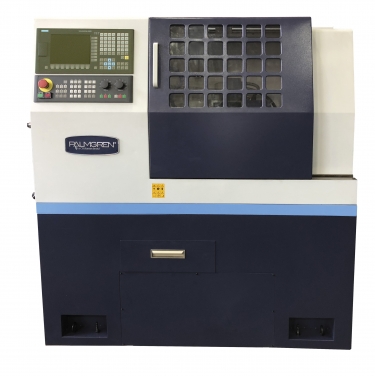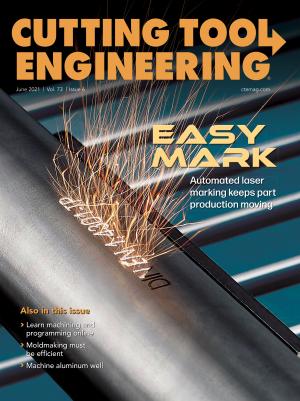Both hobbyists and professionals looking for an economical option for machining small parts can turn to the 127 mm (5") slant-bed lathe from Palmgren.
“When we launched it, everybody loved the little 5" for space savings and overall ease of use,” said Donald Yonkers, parts and service manager at Naperville, Illinois-based C.H. Hanson Co., which owns the Palmgren brand. “You can put this in your garage and be making parts in an hour.”
Suitable for parts 31.75 mm (1.25") or less in diameter, the 5" turning center also can be used at machine shops for short production runs, one-offs and prototyping. The small size and footprint of the lathe — it measures 1.4 m (55") long, 0.77 m (30.25") wide and 1.6 m (63") high — make it a good choice for shops in need of a secondary machine or an additional chuck, according to Palmgren. For larger parts, the company offers a 203.2 mm (8") version of the lathe measuring 2.08 m (82") long, 1.65 m (65") wide and 1.8 m (71") high.
Priced at about $26,000, the 5" lathe certainly falls into the budget category. But Yonkers maintains that users won’t be compromising on part quality.

The 5" slant-bed lathe is a compact, low-priced machine for making small parts at a garage or machine shop. Image courtesy of Palmgren
“If I put this machine next to a (high-end) CNC machine,” he said, “it would do the same part at the same time and you wouldn’t notice a difference between the two.”
In China, every one of the slant-bed lathes is manufactured and tested to ensure that it meets high quality and accuracy standards, according to Palmgren. When the machines arrive at Yonkers’ facility, he tests them as well and reports repeatability accuracy of around ±0.000381 mm (0.000015").
The company attributes this accuracy in part to the use of high-precision linear rails for positioning the x- and z-axes. Another key factor is the rigid construction of the machines.
“They’re built like big CNC machines with accuracy in mind,” Yonkers said. “They have a full cast-iron frame and base, so they don’t twist and move around a lot like some lower-end CNCs do when their frames are bolted together.”
In addition, the 5" machine weighs almost 635 kg (1,400 lbs.), so it’s no lightweight even though it’s compact. The 8" version weighs 1,497 kg (3,300 lbs.).
“It is not something you are going to put on a benchtop, which will affect accuracy,” Yonkers said.
The lathes also feature an easy-to-use Siemens 808 control, according to Palmgren.
Although the control lacks conversational features, “it will guide you through what you need to do,” Yonkers said. “So it is very easy to set up and run even for a beginner.”
He added, however, that the control also offers many advanced features that allow experts to program complex parts. In addition, he said it does a good job of handling third-party programs.
“You can take any program for a two-axis lathe and put it in this control, and it will run with no hesitation,” Yonkers said.
Both the 5" and 8" lathes come with a three-year warranty that includes the control. For users needing expert assistance, Palmgren offers a free app that can be downloaded onto a phone or tablet. These devices serve as a microphone and camera for users as they communicate with him or one of his colleagues, who provide help with programming parts and solving machine-related problems.
Although they offer a number of attractions, these budget lathes have limitations and are not meant to be a low-cost replacement for expensive machines with high-end features.
“If a customer is looking for a multi-axis lathe, (the 5" lathe) doesn’t have that capability,” Yonkers said. “But if there is someone who is looking for a simple two-axis lathe, this is it.”
Contact Details
Related Glossary Terms
- chuck
chuck
Workholding device that affixes to a mill, lathe or drill-press spindle. It holds a tool or workpiece by one end, allowing it to be rotated. May also be fitted to the machine table to hold a workpiece. Two or more adjustable jaws actually hold the tool or part. May be actuated manually, pneumatically, hydraulically or electrically. See collet.
- computer numerical control ( CNC)
computer numerical control ( CNC)
Microprocessor-based controller dedicated to a machine tool that permits the creation or modification of parts. Programmed numerical control activates the machine’s servos and spindle drives and controls the various machining operations. See DNC, direct numerical control; NC, numerical control.
- lathe
lathe
Turning machine capable of sawing, milling, grinding, gear-cutting, drilling, reaming, boring, threading, facing, chamfering, grooving, knurling, spinning, parting, necking, taper-cutting, and cam- and eccentric-cutting, as well as step- and straight-turning. Comes in a variety of forms, ranging from manual to semiautomatic to fully automatic, with major types being engine lathes, turning and contouring lathes, turret lathes and numerical-control lathes. The engine lathe consists of a headstock and spindle, tailstock, bed, carriage (complete with apron) and cross slides. Features include gear- (speed) and feed-selector levers, toolpost, compound rest, lead screw and reversing lead screw, threading dial and rapid-traverse lever. Special lathe types include through-the-spindle, camshaft and crankshaft, brake drum and rotor, spinning and gun-barrel machines. Toolroom and bench lathes are used for precision work; the former for tool-and-die work and similar tasks, the latter for small workpieces (instruments, watches), normally without a power feed. Models are typically designated according to their “swing,” or the largest-diameter workpiece that can be rotated; bed length, or the distance between centers; and horsepower generated. See turning machine.
- turning
turning
Workpiece is held in a chuck, mounted on a face plate or secured between centers and rotated while a cutting tool, normally a single-point tool, is fed into it along its periphery or across its end or face. Takes the form of straight turning (cutting along the periphery of the workpiece); taper turning (creating a taper); step turning (turning different-size diameters on the same work); chamfering (beveling an edge or shoulder); facing (cutting on an end); turning threads (usually external but can be internal); roughing (high-volume metal removal); and finishing (final light cuts). Performed on lathes, turning centers, chucking machines, automatic screw machines and similar machines.



